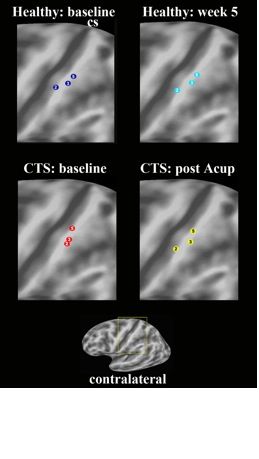Brain Plasticity in Carpal Tunnel Syndrome and its Response to Acupuncture
Project Leader: Vitaly Napadow, PhD, LAc
Project Funding: NIH, NCCAM R01AT004714 Carpal tunnel syndrome (CTS), the most common entrapment neuropathy, is exceeded only by low back pain as a cause of employee absenteeism. Maladaptive neuroplasticity in the brain of CTS patients has been noted by several neuroimaging studies, and includes altered primary somatosensory cortex (SI) somatotopy and primary sensorimotor hyperactivation. We hypothesize that the disability and pain associated with CTS is not only a consequence of the peripheral nerve lesion but also relates to the observed, altered cortical sensory processing. Acupuncture has shown potential as a conservative treatment option for CTS, but its mechanisms of action are unknown. CTS is an excellent model for studying acupuncture mechanisms as clinical improvement can be evaluated by several objective outcome measures in addition to subjective symptom assessments. We propose that acupuncture, a somatosensory conditioning stimulus, can reverse CTS-associated maladaptive neuroplasticity via different mechanisms of neural modulation: focal and systemic. We will derive the contribution of these different mechanisms by randomizing CTS patients into three treatment groups local, distal, and placebo. We hypothesize that local acupuncture can affect brain biomarkers, pain sensation, peripheral nerve dysfunction, and functional deficits, whereas distal acupuncture will only address pain. In Aim 1, we will develop and optimize functional MRI (fMRI) neuroimaging biomarkers for CTS and correlate these biomarkers with more established peripheral clinical and functional deficit metrics. In Aim 2 we will evaluate brain response to acupuncture at both local and distal acupoints in CTS patients, and correlate activity in specific limbic brain regions and the primary sensorimotor cortex with peripheral clinical pathophysiology and SI digit somatotopy. In Aim 3 we will investigate the immediate and longitudinal response in central biomarkers to acupuncture therapy. Hence, we will utilize fMRI neuroimaging to better delineate the central mechanisms by which acupuncture ameliorates CTS pathology. We will derive the behavioral consequences of CTS patients' maladaptive cortical plasticity and the immediate brain and peripheral response to acupuncture stimulation. By understanding the neural mechanisms of different forms of acupuncture therapy, we hope to refine acupuncture utility for CTS and advance rehabilitation options in CTS care.

|

